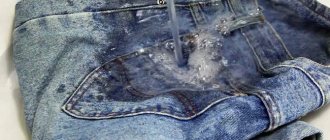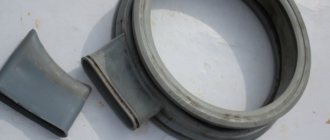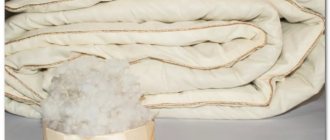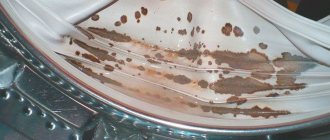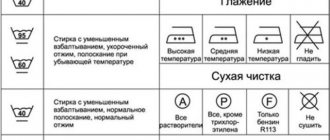With each cycle, the washing machine passes several tens of liters of water with particles of detergents, dirt, hair and other debris, partially deposited on the internal surfaces of the drum, drain pipes and other elements.
An unpleasant odor is a signal that the washer needs cleaning. Recommendations from experienced professionals will help you carry out work to eliminate the problem that has arisen competently, without compromising the further operation of the household appliance.
We will tell you in this article how to remove the smell from an automatic machine at home.
Why does the smell appear?
The stench from the machine permeates the laundry.
Do not use fragrances or rinse aids in an attempt to quickly kill the stench. Random remedies will only temporarily drown out the smell. If you do not destroy the source of the stench, the problem will constantly remind you of itself. Therefore, before you start getting rid of the unpleasant odor in the washing machine, determine the reason why this “aroma” appeared.
Poor quality detergents
Expired conditioner or low-quality powder does not completely dissolve, is poorly washed out and sticks to the walls of the drum, causing a musty smell.
There should not be too much detergent or past its expiration date.
Dirty tray
Sometimes the machine smells due to residues of detergents and limescale deposited on the walls of the plastic powder receptacle. To clean the washing machine tray from foreign odors, use a soap solution.
The container is removed and warm foam is applied to the surface with an old toothbrush. After 10 – 15 minutes, wipe off and rinse with warm running water. Wipe thoroughly. After airing, put it back in place. If the soap does not work, soak the container in a cleaner containing chlorine. After 1.5 hours, the foul-smelling coating will dissolve.
Reference! The powder receptacle is washed and ventilated every 2 - 3 washes to prevent the appearance of odor.
Dirt on parts causes a strong stench
Channel contamination
If the tray is rarely washed, smelly deposits will form on the surfaces of the outlet that carries gels and powders into the drum. To make sure that the stench is coming from the channel, remove the powder receptacle and, using a flashlight, look inside. With additional lighting, traces of dirt and moldy spots are clearly visible.
To deal with the problem without damaging the mechanism, they call a technician from the service center. But sometimes housewives carefully clean this part with a narrow brush used to wash dishes.
Periodically keeping the insides of your machine clean will improve its performance.
Drain filter clogged
Small debris, hair, grains of sand, and animal hair do not fall into the sewer because they are retained on the filter. An unbearable smell will indicate that the device is full of dirt. A symbol will appear on the machine's dashboard indicating the problem.
To restore the operation of the unit and remove the stench, remove the blockage. The filter is located at the bottom of the housing. Place a low container under the compartment or place a cloth loosely. Open the lid and carefully remove the part. Remove clumps of grease-soaked hair and wool. Wash with gel. Wipe dry and ventilate.
Clean elements are collected and installed in a permanent place. The filter is cleaned of debris regularly, at least once every 2–4 months (if there are animals, this is done more often).
To clean the filter, it is better for the housewife to call a specialist
Old hose
Traces of dirt, lint, and powder granules settle inside the hose and cause an unpleasant odor from the machine. Therefore, the hose needs to be cleaned regularly. To do this, run a service wash once every 4-5 weeks - at maximum temperature, without detergents and clothes (sometimes baking soda is added). A dry wash cleans the hose and drum and destroys bacteria that cause stench.
Scale
When water is heated, dissolved mineral salts are retained on the heating element in the form of a white coating. Here, greasy dirt periodically accumulates, and when heated, a foul smell is felt. To clean the electric heater, pour 4 tablespoons into the detergent tray. l. citric acid. Having set the boiling mode, start an empty wash. At the end, turn on the rinse to wash away any remaining granules.
Dirty build-up on the heating element accelerates engine wear
Additional Information! When the heating element is fouled with plaque, the energy consumption and heating time increase. Regular cleaning of the heater saves energy and extends the life of the device.
Clogged sewer lines
Sometimes the washing machine stinks, but the machine is regularly cleaned and ventilated. If a rotten smell also comes from the bathtub or sinks, then the drains are clogged. To change the pipes, they call plumbers. When connecting the hose to the drain, make sure that the flexible tube takes the shape of an arc and does not rise above 0.5 m from the floor. If the hose is connected to the drain correctly, the stench will not penetrate from the machine into the apartment.
Mold
Frequent washing in cool (+30 – 35 ℃) water with quick rinsing causes intensive growth of fungi. Room temperature and moisture are comfortable conditions for the life of microorganisms. Storing dirty clothes soaked in sweat for a long time in a drum also causes fungus to appear. Excess gels and conditioners that are not completely removed from the fabric fibers stimulate the development of microbes.
Mold grows easily on damp surfaces
Abuse of detergents
When adding powder before washing, consider:
- degree of contamination of clothing;
- instructions on the packaging of the detergent;
- hardness of water;
- drum load;
- divisions marked on the compartment.
Excess undissolved granules and traces of gels are not completely rinsed out of the fabric and remain on the hose and filter, causing an odor.
Reference! On average, to wash 5 kg of laundry, 125 g of powder is required (heavily soiled laundry is pre-soaked and washed by adding 150 g of dry granules). The consumption of concentrated drugs is reduced (the dosage is determined according to the instructions). To wash clothes in soft water, less detergent is used.
It is better not to exceed the amount of detergents according to the stated norm
Step-by-step ways to neutralize odor
Experimenting with powders and conditioners
Very often it is detergents that cause the smell. Cheap powders do not dissolve completely, therefore, after washing, the machine parts remain not clean, but stuck with microparticles of these miracle powders.
And, if you wash often, then there will be no problems. And, if once a week or less, then during this time mold has time to develop. Moreover, on any parts, even on those that cannot be “reached” by a run with citric acid.
Removing odor from the drum
Here we are not talking about whether the drum is dirty on the inside. The drum may be covered with mold from the outside, which means that only a workshop, a complete disassembly of the machine and significant expenses will save you.
There's a lot of dirt there, believe me. If you regularly do preventive maintenance, which you will read about below, then such a moment will come much later, but it will still come.
Removing odor from the powder tray
If you have a top-loading machine, then everything is simple. Take out the drawer and wash it thoroughly with an old toothbrush. If we are talking about a horizontal machine, where there is almost no access to the ditch, then you will have to dodge and clean the compartment with improvised means.
For example, you can wrap cotton wool around a thin, long knitting needle, soak it in alcohol or bleach and wipe it. You can simply pour bleach into it, but do not forget to then idle the car several times.
Cleaning the detergent supply channel
If it is clogged, then a knitting needle with cotton wool will help here too. But, in theory, it should be cleaned at the moment when you start a single wash with lemon.
And, frankly, this is not the place that is the source of the damage and where the smell might come from. But, careless owners can do anything, so we are listing this place just in case.
Cleaning the drain filter
In principle, there is almost no smell of fungus from the filter. Rather, it may smell, so to speak, not of fungus at all, but of garbage, since pieces of food may get in there. But, in any case, you need to take out this filter, check it and wash it thoroughly if necessary.
Removing scale from the heating element
The heating element, too, is unlikely to become covered with fungus. It becomes overgrown with a “fur coat” of scale. It, of course, can give off some very faint odor, but it has nothing to do with the smell of mold.
So, be that as it may, since you’ve already gotten there and “gutted” the machine, it’s worth paying attention to the heating element and cleaning it. You can remove it and soak it for a day or three in a strong lemon solution, this helps.
But, in general, heating elements need to be cleaned not only for the sake of cleanliness, but for the sake of saving energy.
The more coating the heating element is, the more current it draws to give the temperature required for washing. That is, it needs more power and time to heat the water. And such a load affects the motor... Everything in the machine is interconnected, just like in the human body.
Changing or cleaning the drain hose
Everything is simple here. Unplug it and smell it. If there is a smell, try soaking it in a bleach solution for a day. If this doesn’t help, then buy a new one and don’t fool yourself. It's not that much money.
Looking for stagnant water
It happens that the smell comes from the container below, where there is always some water left. In general, this is some kind of strange and exceptional case, since, in theory, there should always be water there to protect the rubber from drying out.
But, if you installed the machine incorrectly, at the wrong level, then there may be a misalignment and there will be much more water there than necessary. In general, we can’t say exactly why this happens, but in that exact place there definitely shouldn’t be a smell. Maybe you were away for a couple of months? Then maybe there was some kind of stagnation. And even then, this cannot be.
We are fighting with the housing office and demanding replacement of pipes
If your laundry starts to smell unpleasant, then don’t rush into fanfare and check if there is a smell from another tap that comes from the same pipe? Sometimes it is completely unnoticeable, for example, in the same bathroom.
Let’s say the first portion of water has some kind of smell, and then it is drained and, in the end, you simply don’t notice that there is a smell. The first batch of stagnant water from the pipes is drawn into the machine and it runs there throughout the entire cycle.
In general, if the problem is in the pipes, then the problem is the pipe. We will have to raise all the neighbors to their feet, collect signatures and go to the utility services, demanding that the pipes be repaired. This is a troublesome and slow task.
In our country, even in case of accidents, when the basement is completely flooded with sewage water, they don’t fuss too much, and in this case, even more so... But no one is stopping you from being persistent. What should we do if in our country they won’t move without a kick?
Traditional methods
Sometimes simple methods and available home remedies can help remove a nasty smell from an automatic washing machine without leaving a trace.
Hot water
It’s worth starting to fight microorganisms that cause stench with a basic technique. At a temperature of +90℃, turn on the service wash for 2.5 - 3 hours without auxiliary products. If the bacteria do not die and the stench remains, they try other methods.
Very hot water with baking soda and vinegar will help solve the problem.
Vinegar
Acetic acid destroys bacteria that cause stench; removes stuck dirt inside the hose; dissolves limescale. To clean, pour 1 glass of vinegar (9%) into the powder compartment; select long-term cleaning in the boiling mode. 15 minutes after turning on, the machine is stopped for 40 - 50 minutes for the product to take effect. After the cycle is completed, the parts are rinsed and the seals on the door are wiped. This cleaning method is used every 4 to 5 months.
Additional Information! Before the first wash, the machine should be disinfected. To prepare the working solution, add 15 ml of table vinegar to 0.5 liters of water (70% essence is diluted in a ratio of 1:7). A napkin is moistened with liquid and the surfaces of the device are wiped. Then turn on the idle wash without spinning.
Soda
Sodium bicarbonate is an alkali that quickly gets rid of scale and fungus. To prevent the appearance of odors, 2.5 tablespoons are periodically added to the powder. l. soda If a “smell” has already appeared, the dose of the substance is doubled. Wash at a temperature of +30 – 35℃, choosing the economy mode. After treatment, wipe the machine with a dry cloth.
Sometimes soda ash is used instead of baking soda:
- the substance is dissolved in water;
- use a sponge dipped in liquid to wipe the internal surfaces, rubber seals, and door;
- after 30 minutes, wash off the soda;
- start an empty wash.
Sodium bicarbonate is milder than soda ash, so this product is used more often.
Baking soda helps remove stench and remove stains
Vinegar + soda
To quickly eliminate an unpleasant odor from a washing machine, pour 0.2 liters of vinegar (9%) into the drum, and put a mixture of 50 ml of water and 2 tablespoons into the powder receptacle. l. soda Turn on the continuous boiling mode (without spinning). After rinsing, the unit is wiped and ventilated. This technique helps even in advanced cases to destroy scale, greasy growths, and stench.
Reference! Before cleaning, wear a respirator and gloves to protect the respiratory tract and skin from the aggressive action of cleaners.
Bleaching
Chlorine solutions act quickly but aggressively. By destroying bacteria, chlorine destroys the material from which the parts are made:
- corrodes the top layers of plastic, causing yellow spots to appear;
- increases metal corrosion;
- breaks the elasticity of rubber seals.
Experts do not recommend pouring preparations containing chlorine into the drum. But these products will clean the filter if other methods are powerless: the part is soaked for an hour in a Domestos or Belizn solution, then thoroughly washed and dried. Chlorine leaves a pungent odor, which can be removed by empty washing and prolonged airing. If the substance causes an allergy, the procedure is abandoned.
A strong product is rarely used so as not to damage parts
Copper sulfate
Copper sulfate crystals completely destroy mold and germs. To prepare a working solution, 18 g of the substance are diluted in a liter of water. Use a soft cloth soaked in liquid to thoroughly wipe the parts of the unit. After treatment, start an empty wash.
Lemon acid
If foreign odors appear, you should clean the washing machine with granulated citric acid. The substance inhibits mold growth and kills bacteria that cause stench. 60 g of citric acid is poured into the detergent compartment and the service wash is turned on. The operation is completed by rinsing.
To preserve the washing unit after oxalic and citric acid, start the rinsing process
Oxalic acid
The toxic substance and salt derivatives (oxalates) act quickly but aggressively:
- reduce water hardness;
- disinfect surfaces;
- clean metal parts from scale;
- kill germs;
- remove traces of rust.
Acid and oxalates are added to disinfectants and bleaches. If the manufacturer does not prohibit the use of aggressive substances to clean the device, oxalic acid is poured into the drum and the treatment is started for half an hour at +90℃ with additional rinsing.
Additional Information! The aggressive substance irritates the mucous membranes, respiratory tract and skin, so before the procedure wear glasses, a respirator, and rubber gloves.
How to clean the cuff and drum
What to do, how to remove the smell in an automatic washing machine if its source is the cuff and drum? These car parts are not difficult to obtain.
First, carefully push back the folds of the cuff and carefully remove any debris that has accumulated there with a cloth.
Then we soak a rag in some kind of disinfectant such as bleach or vinegar, and thoroughly wipe the cuff. We do the same with the tank. We wipe its walls with a product that contains chlorine to kill fungi and microorganisms. You can also use other means for this.
Household chemicals
To choose the right product, the housewife needs to test several.
When available products do not get rid of the rotten smell from the washing machine, household chemicals are used. The dose of the substance is calculated according to the instructions. After treatment, wash dry with an additional rinse cycle.
Tiret
Disinfects; Safely removes lime and greasy deposits and scale. Neutralizes stench. Pour in the gel and start the cycle at +60℃. To improve the performance of the machine, apply it once every six months.
Doctor ten
Acid-free antibacterial powder contains triclosan, alkali metal carbonates. Disinfects. Removes limescale build-up from the internal surfaces of the unit and cleans the heating element. Dissolves detergent residues. Prevents the formation of mold in the machine and in the drain pipe.
The cleaner quickly eliminates the causes of stench
A pack of powder is poured into the drum, and the washing is turned on at high temperature (without spinning). For soft water use 2-4 times a year, for hard water – up to 10 times.
Reference! Citrus peels or peeled potatoes placed in an ajar machine after washing will absorb foreign odors.
Chistolan-super for removing scale
Inexpensive effective remedy. Contains citric acid and sodium chloride. Dissolves scale. Does not damage rubber, plastic, metal parts. Set normal mode at +70℃. Wash without laundry.
Chistolan automatic – washing powder
Powder containing soda ash, tripolyphosphate and sodium sulfate is added to the detergent with each wash. Suitable for all types of fabric. Reduces the consumption of detergents. Prevents the formation of plaque, softens water, removes scale. Helps increase the life of the machine. It is used economically: with water of medium hardness, take 25 g of powder per 10 liters; with hard water, double the dose.
Special products are effective and at the same time do not damage rubber, plastic and metal.
Refine
Due to the high concentration of sodium carbonate (soda ash) and Trilon B, it intensively softens and removes dirt; dissolves rust. Manufacturers recommend adding 1 table for each wash in soft water. l. granules, hard – 2.5 – 3 table. l.
Dr Beckmann
Available in liquid and powder form. Contains citric acid, glycerin, activated carbon, surfactants. The antibacterial drug destroys dirt even in hard-to-reach areas. Extends the service life of the machine. Anti-corrosion and softening components do not damage metal or rubber.
MultiDez-Teflex
A concentrated chlorine solution destroys mold, fungal spores, viruses, and bacteria that cause stench. Does not damage metal or rubber elements. The parts are wiped with liquid. Without adding additional substances, wash the laundry or choose an empty wash (30 - 60 minutes).
Pipe cleaners will help clean the insides of your car.
Bagi Schumanit
Aggressive concentrated liquid. Thanks to a mixture of organic acids, it quickly removes water scale, rust, and limescale. Increases the heat transfer of the heating element. 0.2 liters of concentrate are poured into the powder compartment, the machine is turned on for 15 minutes, then the rinse program is selected.
Mellerud
Eliminates pollution and neutralizes stench. Pour 0.25 liters of solution into the detergent container, select a short program followed by rinsing. Used for soaking contaminated removable parts (take 0.2 liters of the drug per 8 liters of warm water). After 25 - 35 minutes, scrub with a brush and rinse with running water. The seals are wiped with a cloth soaked in the solution. After 15 minutes, wash off.
Frau Schmidt
The active ingredients include citric acid, sodium bicarbonate, and trisodium citrate. The tablets quickly corrode scale and fat deposits; removes residual detergents. One tablet is placed in the machine and the normal program is turned on without spinning.
Tablets are suitable for all car models
Cillit bang
Cleaning compositions of this brand clean surfaces from various types of contaminants. A spray containing chlorine gets rid of black mold on the rubber seal (spray on the rubber, after 20 minutes remove with a damp sponge, wipe off). Anti-Plain + Shine removes traces of rust, greasy dirt, and dissolves excess detergents on plastic and metal. The sprayer helps remove dirt in remote corners and at the joints of parts.
Additional Information! Before applying the compositions, the treated surfaces are moistened.
Dishwasher cleaning tablets
For the treatment of dishwashing equipment, tablets are produced that stop the growth of bacteria and prevent the formation of scale, rust, and lime deposits. The drugs also dissolve fat and protein deposits.
A powerful remedy is to combine boiling and dishwashing tablets
Therefore, these products are also suitable for eliminating bad odors from the washing machine. One capsule is placed in the powder compartment, and 2 - 3 in the drum. Start the boiling mode. Stop after 35-45 minutes. After 2 hours, treatment is resumed.
Buy chlorine-free hypoallergenic tablets containing a complex of washing and cleaning ingredients (Filtero 7 in 1; Somat Machine Cleaner; Finish Rinse).
Cleaning the powder container with vinegar
In addition to the internal equipment of the machine, the tray into which the detergent is supplied needs cleaning. To remove limescale from the walls of a container using vinegar, you must:
- dilute half a glass of 9% vinegar with hot water (not lower than +90 ℃);
- remove the tray from the machine and place it in a container with the prepared solution so that it is completely covered with liquid;
- leave the container soaked, preferably overnight or for a day;
- Rinse and wipe dry all compartments of the tray with a cloth.
An alternative cleaning solution is a mixture of vinegar and baking soda. You should prepare a paste from the above ingredients, apply it to the walls of the container and wait a couple of hours. After this, you can clean the compartments with an old toothbrush and rinse the clean tray under running water.
Vinegar and baking soda are excellent stain removers.
To prevent the formation of plaque on the walls, it is important to regularly wash and disinfect the powder container. The vinegar solution will help you cope with the tasks.
Call a plumber
To quickly remove the stench without damaging the equipment, they call a technician from the service center. The plumber will determine the source of foreign odors and perform the following procedures:
- wash the drain filter;
- cleans the drum, powder receptacle, rubber seals, door;
- will remove scale from the heating element;
- diagnoses the condition of the device, replaces worn parts that cannot be restored.
The technician will check the correct connection of the unit to the sewer pipes and correct any errors.
Faulty sewerage - source of odor
Sometimes the machine smells like a sewer. Sometimes this is caused by actual problems in the sewer system, and sometimes it can occur due to errors in the connection or operation of the machine.
When the smell of sewage appears in your machine immediately after installation, the cause may be improper operation of the drain hose. Here you should carefully study the instructions again and, following them exactly, reinstall the hose.
If the cause of the stench is problems with the sewerage system, then the smell will be felt not only in the machine and the clothes washed in it, but also from the sink. This means that there is a blockage in the sewer pipes and it is necessary to clean them.
An unpleasant smell from the washing machine may be due to a clogged drain filter.
Smell from laundry
Washed items smell unpleasant if:
- dirty clothes are stored in the washing machine until washed;
- the dosage of detergent has been exceeded;
- the hose is not connected correctly;
- low-quality gels and powders were used;
- the filter is clogged;
- In old units, the valve is worn out, so after draining, residual water accumulates.
To remove the smell that appears after washing, the treated items are aired. But this method will not remove the “aroma” of dampness or mustiness. To cope with such a nuisance, you need to destroy the bacteria and fungus that cause the stench. Smelly laundry will have to be washed, but before re-loading into the drum, the items are soaked for 2 - 4 hours with the following product:
- salt;
- sodium borate;
- hydrogen peroxide;
- ammonia
The specialist will disinfect the surfaces and remove mold from the car.
After re-treatment, the items are thoroughly wrung out and air dried. Smelly pillowcases and sheets should not be placed in the closet: the rest of the linen will become saturated with an unpleasant odor. A tall cup is placed on a cabinet shelf, into which a bottle of iodine is placed (instead of a cork, the neck is plugged with cotton wool: through the loose fibers, antiseptic vapors will enter the air and destroy fungal spores).
Reference! Linen washed in a new machine often smells like rubber (the stench intensifies as the temperature rises). To prevent trouble, the first 1–3 washes are run without laundry and detergents. Gradually the smell will go away.
Is it possible to use vinegar to clean a washing machine?
Almost every housewife has vinegar in her house. Due to its affordable price and high efficiency, it is advisable to use it for cleaning a washing machine. It has a strong corrosive effect, which helps to break down even old plaque or mold coating on equipment parts. Using a vinegar solution you can:
- get rid of scale on the internal elements of the machine;
- eliminate unpleasant odors caused by rot or stagnant water;
- clean off any dirt and mold.
Among the parts of the washing machine, the tubular electric heater (TEN) suffers most from scale.
Cleaning your washing machine with vinegar is a proven method for eliminating mineral deposits, mold and dirt. The effect of using a vinegar solution for a washing machine will exceed all expectations if you carry out the procedure consistently and taking into account certain rules.
How to remove the smell of gasoline from a washing machine
Things that smell of kerosene or gasoline should not be machine washed: the internal surfaces of the machine will quickly absorb and retain the pungent odor for a long time. After subsequent washes, the laundry will emit a strong stench.
If clothes contaminated with petroleum products get into the machine, run 3 dry wash cycles:
- 0.25 kg of baking soda is poured into the powder receptacle, the temperature is selected at +30℃;
- 0.25 liters of table vinegar is poured into the detergent compartment (the temperature is doubled);
- Empty wash (spin is turned off).
Vinegar and soda will help get rid of the smell of gasoline.
Wipe the treated device and ventilate it for 1 - 3 days. Then they put in an old towel to see if the stench has gone away or not. If the method does not work, store-bought drugs are used:
- Filtero - liquid eliminates even stubborn odors and removes scale;
- dr. Beckmann removes stench, dissolves dirty deposits;
- Frau Schmidt - tablets disinfect parts, remove foreign “odors”, and increase the service life of the machine.
If this technique does not work, use Whiteness. Bleach is diluted according to instructions. Set the temperature to +30℃ (wash without laundry). After the end of the cycle, run a service wash without additives to remove traces of chlorine. Chlorine bleach is not suitable for every model, so it is worth re-reading the instructions for the machine.
Additional Information! If the smell of petroleum products persists, the internal parts of the unit are manually cleaned with degreasers.
How to replace the rubber hatch cover
If mold remains in the washing machine after cleaning the cuff, then you will have to replace it. In order for such a replacement to be successful, you must first of all buy not just a similar one, but one specifically designed for your model, and only after making sure of their identity proceed with the replacement.
The method of attaching the cuff to the machine varies from model to model, and the method of detachment will also vary.
One will be for plastic clamps, the other for metal ones, secured with latches, springs or screws. Therefore, read the instructions carefully.
Violation of operating rules causing a stench from an automatic machine
Wet washed and dry dirty laundry should not be stored in the drum of the machine.
Housewives try to quickly get rid of bad odors from the washing machine, but do not think that the stench is caused by incorrect operation. The following mistakes are often made:
- Leave wet clothes in the drum to allow any remaining water to drain. Bacterial growth increases in a humid, warm environment.
- Do not ventilate the powder receptacle; close the door immediately. Equipment manufacturers recommend leaving the door open for 5–6 hours so that the moisture has time to evaporate.
- They store dirty laundry not in wicker baskets, but in a washing machine, thereby creating a breeding ground for germs.
- Pour concentrated gels and rinses without measure. Thick products are not completely washed off (especially in cool water), this causes mold and bacterial growth.
Regular washing at low temperatures creates conditions for the appearance of an unbearable odor.
The smell of dirty laundry easily takes root in the car.
Tips for Extending Lifespan
To eliminate problems and extend the life of household appliances, experts recommend following five rules.
- Storing clothes in a basket. Dirty laundry should be placed not in the drum, but in special baskets. Moreover, the storage container must allow air to pass through, otherwise bacteria will begin to accumulate on the wet, soiled fabric.
- Alternating temperature conditions. Fans of “quick washing” should alternate short cycles with long ones, once a week change the temperature from 40 to 60-80°C, and at least sometimes wash on a full cycle at 90°C.
- Use suitable powder. It is recommended to use powders intended only for vending machines, observing the exact dosage. You can use liquid products, which, as a rule, are washed away without leaving a residue.
- Washing filters. Filters should be cleaned periodically. The inlet filter is located inside the water supply opening and should only be removed after turning off the taps. The drain filter is located at the bottom, on one of the walls of the machine. Before unscrewing it, you need to place a rag or a low basin - a lot of water usually pours out of the hole.
- Using descaling products. You should soften the water and periodically use cleaners for heating elements. Expensive powders already contain agents that protect heating elements and parts, so additional cleaning is required no more than once a week.
The owners of the car are not always at fault. Often, unskilled technicians incorrectly connect equipment to the drain, and some of the waste water remains inside the hoses. This can happen when the machine is installed at an angle. If the hose is kinked or connected too high, then the center of the stench is most likely located here. In addition, the smell can come from the drain if there is a clog in the drain. “Aromatic” amber is emitted by the sink, bathroom, and other plumbing fixtures in the house.
Preventative techniques
If you follow simple rules, you won’t have to look for a way to deal with the stench from your washing machine:
- Washed items are rinsed thoroughly.
- Buy high-quality detergents for washing in the machine. The granules of such powders do not stick together, dissolve well in water, and foam moderately.
- You cannot pour dishwashing concentrates into the machine: excess gel is not completely rinsed out of the fibers and remains on the surfaces of the unit. Excessive foaming causes damage to the heating element.
- Before loading, remove hair and dried dirt from clothes; remove foreign objects from pockets. Check whether buttons and small details are securely sewn on.
- After wet processing and washing, the drum is thoroughly wiped and ventilated.
- Dirty clothes should not be stored in the drum as this increases the risk of mold growth. Contaminated laundry is placed in baskets or containers that allow air to pass through.
- The cuff is a rubber seal installed between the drum and the door so that water does not spill out of the appliance during washing. Without regular cleaning and drying, water stagnates here, mold and dirty deposits appear. This part is periodically wiped with diluted acetic acid.
- The device is installed on a flat surface, according to the diagram in the instructions.
- After finishing washing, wipe the internal surfaces of the machine, rubber seals and tray with a damp soft cloth. Then wipe dry and ventilate.
- The corrugated hose quickly becomes dirty and is difficult to clean from deposits. If it is not possible to remove contamination from the inside, the part is replaced with a new one.
If you take care of the cleanliness of your machine, the smell of freshly washed laundry will only delight you.
When trying to get rid of the stench, you must not exceed the permissible concentration of cleaning agents or use different agents at the same time: aggressive substances will damage plastic and rubber parts and cause metal corrosion.
Bacteria and mold on the rubber seal and in the drum
Sometimes a musty smell appears because the machine is not level. Then all the water does not leave the machine and stagnates inside, becoming a breeding ground for mold or bacteria. Most often the tank suffers from this.
High humidity remains in it even if you simply do not dry it, and if the machine is crooked, then moisture stagnation is guaranteed.
Then a smell may appear from the drum. It may also contain sediment for some reason.
Sometimes the machine smells bad due to the condition of the hatch cuff. Liquid also often stagnates in its folds, various little things and undissolved particles of used products settle. To remove odors, you need to thoroughly rinse these parts in the machine.
Professional products: ranking of the best
Industrial preparations for treating a washing machine and its individual elements have significant advantages over traditional methods: they do not harm the structure and have proven effectiveness. Their use allows you to quickly eliminate the cause of the unpleasant odor; periodic use is a reliable prevention of its reappearance.
IMPORTANT! Before purchasing the product, it is recommended to study the composition and its indications for use presented on the packaging. This is due to the fact that there are both universal and highly specialized preparations on sale, designed to solve a specific problem (descaling, mold control, and so on).
Effective products included in the ranking of the best include household chemicals presented in the table.
Table. Review of popular washing machine cleaning products
| Name | Manufacturer country | Description |
| Beckmann | Germany | A universal product against scale, dirt and mold. Quickly removes unpleasant odors, suitable for treating individual machine elements |
| Magic Power | Germany | One of the best preparations for treating elements of household appliances. Effectively removes deposits from heating elements and drums. Available in powder or gel form |
| Topper 3004 | Germany | Designed to destroy scale of varying severity and persistent odor. Available in 250 ml bottles, one is enough for 2 uses |
| Schnell Entkalker | Germany | Quickly and effectively removes deposits from machine elements. Suitable for use with multi-layered scale, severe mold and persistent amber |
| Kaneyo | Japan | The product has a pronounced antimicrobial effect, quickly eliminates dirt, mold, and stench. Actively fights deposits |
Step-by-step instructions for the selected product are presented on the packaging. It is important to familiarize yourself with it before use.
Professional washing machine cleaner
Features of using professional products:
- Some of the preparations are poured or poured into the powder compartment (for example, Magic Power), others are placed in a drum (Topperr 3004, Kaneyo).
- Then they start the wash, but without the items. The temperature is usually set around 40-60 °C.
- Certain preparations (Schnell Entkalker) must be introduced into the machine with water (without laundry) and left for some time (for 1 hour at the beginning of the operating mode and for the same amount at the end). This is necessary to remove stubborn plaque.
- The Beckmann product can be placed in a drum and can also be used to wipe individual parts of the machine. If the dirt and odor are persistent, you can soak them in the solution.
- The volume of most products is designed for 1-2 applications.
Prices for washing machine cleaner
Washing machine cleaner
Prevention of unpleasant odors
It is better to avoid the problem than to solve it. If you do not want to constantly deal with mold and stench from the drum, follow these simple recommendations:
- do not leave dirty or washed laundry in the machine drum;
- after washing, ventilate the unit;
- regularly prevent fungi and scale;
- when washing “smelly” items stained with fuel and other caustic compounds, first rinse the clothes by hand and then put them in the drum;
- monitor the quality of washing powders and gels, do not purchase dubious products;
- wash things more often at high temperatures, constant “cold” washing leads to the appearance of fungus;
- If there is the slightest problem with the operation of the unit, seek professional help.
By adhering to these rules, you will improve the quality of the machine and extend its service life.
Service center services
Some owners find it difficult to pay a little attention to their household appliances, so they turn to the services of specialized service centers to clean the washing machine from odors and dirt. The cost of such work is low, because no parts need to be changed, but it will take at least 1 hour. Moreover, even if you regularly wash the tray and ventilate the drum, there are still places where organic matter accumulates. Disinfecting all parts will help get rid of them. It is quite possible to order such services in our service center, and they will be provided at the proper level.
Specialists will perform the following work:
- They will disassemble the equipment, or rather, dismantle those parts in which accumulations of organic matter are most likely formed.
- All parts will be cleaned and all components will be disinfected.
- They will perform forced drying after treatment, because remaining moisture can cause the unpleasant odor to spread again.


